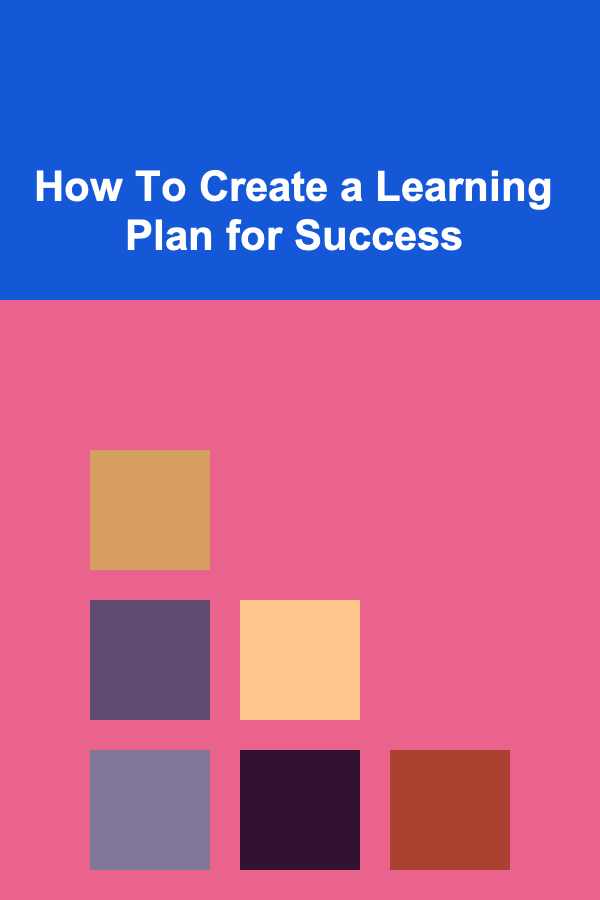
How To Create a Learning Plan for Success
ebook include PDF & Audio bundle (Micro Guide)
$12.99$10.99
Limited Time Offer! Order within the next:

Creating an effective learning plan is a fundamental step towards achieving academic, professional, and personal success. A learning plan acts as a roadmap, guiding individuals toward their goals by focusing efforts on structured and strategic approaches to acquiring knowledge or skills. Whether you are a student aiming to excel in exams, a professional pursuing career growth, or an individual learning a new skill, a well-crafted learning plan can be the key to your success.
In this article, we will explore the essential components of a learning plan, how to create one that works for you, and the strategies you can implement to stay motivated and achieve your desired outcomes.
Understanding the Importance of a Learning Plan
A learning plan is more than just a schedule or a list of tasks---it is a thoughtful framework that ensures your learning is purposeful, focused, and measurable. The significance of a learning plan can be summarized as follows:
- Clarifying Goals and Objectives: A learning plan forces you to define your goals clearly. Whether the objective is to master a particular topic, develop a new skill, or prepare for an exam, having a clear purpose helps to guide the learning process.
- Prioritization and Focus: With a structured plan, you can prioritize the most important topics or skills, preventing distractions and helping you focus on what truly matters.
- Efficient Use of Time: A well-organized plan allows you to allocate your time wisely, ensuring that every moment spent learning is productive.
- Tracking Progress: Learning plans offer measurable goals, making it easier to track your progress over time. This feedback helps adjust strategies if needed and provides motivation by showcasing how much you've accomplished.
- Adaptability and Flexibility: Life is unpredictable, but a learning plan includes contingencies for changes and setbacks. Flexibility within your plan helps you stay on course despite challenges.
Now that we understand the significance of a learning plan, let's break down how to create one.
Step-by-Step Guide to Creating a Learning Plan
Creating a learning plan involves several key steps, from setting clear goals to organizing your time effectively. Below is a detailed, step-by-step process to help you craft your personalized learning plan.
Step 1: Define Your Learning Goals
The first and most important step in creating a learning plan is to define your learning goals. Ask yourself: What do you want to achieve? Your learning goals will shape every aspect of your plan, so it's important to be specific.
For example:
- Instead of setting a vague goal like "I want to learn Spanish," set a more specific goal like "I want to be able to have basic conversations in Spanish within six months."
- If you are preparing for an exam, make your goal measurable, such as "I want to score 85% or higher on the final exam."
Tips for Setting Effective Goals:
- Make them SMART: Your goals should be Specific, Measurable, Achievable, Relevant, and Time-bound.
- Be realistic: Setting overly ambitious goals can be demotivating. Start with achievable objectives and work your way up.
- Include both short-term and long-term goals: A mix of short-term and long-term goals ensures that you have both immediate tasks to work on and a broader vision for your future.
Step 2: Assess Your Current Knowledge and Skills
Before diving into the learning process, it's important to assess where you stand in relation to your goals. What do you already know? What skills do you already possess, and what do you need to develop further?
Key Questions for Self-Assessment:
- What is my current level of proficiency in the subject or skill I want to learn?
- Are there any gaps in my knowledge or skills that I need to address?
- What resources (books, courses, tutorials, etc.) are available to me?
- How much time can I realistically commit to learning each day/week?
This self-assessment will not only help you identify the resources you need but also enable you to break down your learning plan into smaller, more manageable chunks.
Step 3: Break Down the Learning Process
After defining your goals and assessing your current skills, break down the learning process into smaller, achievable tasks. Think of this step as a roadmap, where each small task will guide you to the next.
For example:
- Topic A: Break down a broad subject like "Marketing" into smaller subtopics such as "Social Media Marketing," "Content Strategy," and "SEO."
- Skill B: If you want to learn programming, divide your learning into logical steps: Learn the basics of Python, understand variables and data types, practice conditional statements, etc.
Breaking down your goals will give you a clear pathway and allow you to focus on one task at a time, reducing overwhelm.
Step 4: Create a Timeline
Time management is critical in any learning plan. Now that you have broken down your goals into smaller tasks, set deadlines for each one. Be realistic about how much time each task will take and how much time you can devote to learning each day.
A sample timeline might look like:
- Week 1--2: Learn basic grammar concepts in Spanish.
- Week 3--4: Practice speaking basic phrases and introduce vocabulary.
- Week 5--6: Engage in simple conversations with language partners.
- Month 2: Focus on fluency, conversational skills, and cultural knowledge.
Step 5: Identify Resources
What resources will you use to achieve your goals? Your resources might include textbooks, online courses, video tutorials, mentors, podcasts, or hands-on practice. The key is to use a variety of resources to reinforce your learning and ensure you're engaging with the material in different ways.
Types of Learning Resources:
- Books: In-depth reading materials that provide theory and background knowledge.
- Online Courses: Structured courses with video lessons, quizzes, and assignments.
- Websites and Blogs: Interactive platforms that offer information and tips from experts in the field.
- Workshops and Seminars: Live events that provide opportunities for networking and real-time feedback.
- Mentors: Experienced professionals who can guide your learning journey with advice and encouragement.
Choose resources that suit your learning style and ensure that you have access to the material you need.
Step 6: Implement Active Learning Strategies
Simply passively reading or watching videos will not yield significant results. To ensure deep learning and retention, implement active learning strategies. These methods engage your mind actively, helping you internalize the material.
Active Learning Techniques:
- Practice: If learning a new language, speak it regularly. If learning programming, code every day.
- Teach Others: Explaining what you've learned to others reinforces your knowledge.
- Take Notes: Jot down key points in your own words.
- Ask Questions: Challenge yourself by asking questions about the material and seeking answers.
Step 7: Track Your Progress
As you work through your plan, tracking your progress is vital for staying motivated and on course. Use a journal, app, or spreadsheet to record your achievements. Reflect regularly on your progress and make adjustments to your learning plan as needed.
How to Track Your Progress:
- Set Milestones: Break your learning into manageable milestones and celebrate when you achieve them.
- Monitor Results: Take regular quizzes or assessments to gauge your understanding.
- Seek Feedback: Get feedback from mentors, peers, or online communities.
Tracking progress will not only keep you motivated but will also provide insight into areas that need improvement.
Step 8: Stay Motivated and Overcome Obstacles
Throughout your learning journey, you may face moments of doubt, procrastination, or frustration. The key to overcoming these obstacles is staying motivated and pushing through challenges.
Tips for Maintaining Motivation:
- Set small, achievable goals: Achieving smaller goals keeps you motivated and provides a sense of accomplishment.
- Visualize success: Picture the positive outcomes that will come from mastering the skill or knowledge.
- Create a study routine: Consistency is key. Set aside dedicated time each day to focus on learning.
- Reward yourself: Celebrate small victories to maintain enthusiasm.
If you encounter setbacks, remember that learning is a process. Use obstacles as opportunities to learn from mistakes and adjust your approach.
Conclusion
Creating a learning plan for success involves careful goal-setting, self-assessment, effective time management, and the implementation of active learning strategies. By breaking down your goals into manageable tasks, setting a realistic timeline, and tracking your progress, you ensure that every step of your learning process is purposeful and focused.
Whether you are learning for personal development, academic achievement, or career advancement, having a structured plan will provide the framework needed to stay organized, motivated, and successful. Remember, the key to success lies in persistence, adaptability, and the continuous desire to grow. Stay focused, remain flexible, and keep pushing forward, and your learning plan will be a valuable tool in achieving your desired outcomes.

How to Create a Checklist for Enhancing Your Skin Health
Read More
How to Enhance Your Kitchen with Simple Staging Tips
Read More
How to Plan a Weekend Hobby Room Makeover
Read More
How to Prepare Mentally for Weight Loss
Read More
How to Store Towels and Linens Efficiently in Your Bathroom
Read More
Designing Minimalist Presentation Slides: A Deep Dive
Read MoreOther Products

How to Create a Checklist for Enhancing Your Skin Health
Read More
How to Enhance Your Kitchen with Simple Staging Tips
Read More
How to Plan a Weekend Hobby Room Makeover
Read More
How to Prepare Mentally for Weight Loss
Read More
How to Store Towels and Linens Efficiently in Your Bathroom
Read More